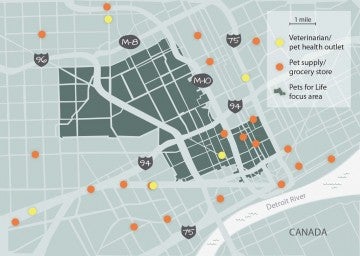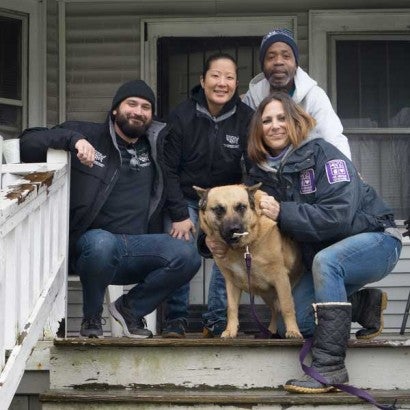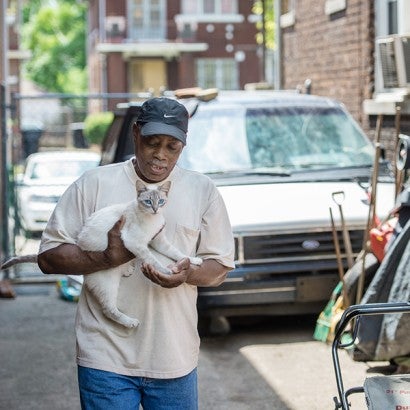“There's another house burning,” Kristen Huston says, steering her white sedan, its trunk loaded with pet supplies, into one of the neighborhoods where her organization, All About Animals Rescue, does outreach. “Do you smell it?”
In the back seat, HSUS staffers Jason Schipkowski and Ashley Mutch sniff the air. Even with the windows rolled up—it’s early spring, but a thin sleet is falling—they can smell it: plastics, wood, a taint of smoke. It’s impossible to tell where it’s coming from.
Detroit is famous for its suspicious fires. The problem started with pre-Halloween pranks in the 1930s, but as years passed, Detroit’s automobile industry crumbled and a huge chunk of the population moved away, the city’s problems became more entrenched. The remaining population suffered the impact of that plunging economy and tax base. Arsons became common. The wave of fires peaked in the 1980s, but still, every day in Detroit, more houses burn than the police can investigate.
Driving through the neighborhood, Huston passes abandoned houses—windows broken, shingles scattered in the front yard leaving bald patches on the roofs. Now and then, there’s a burnt-out shell, the blackened beams and collapsed walls standing in spiky piles between empty homes and others that are proudly occupied, where lights are on and chairs sit on front porches and small, pristine gardens display their early buds next to streets cluttered with trash.
Huston pulls up at a house and steps out to greet Jerome Ross, a tall, middle-aged man who’s come outside to meet them. His two dogs are tethered in the yard, the worn patches outside their wooden doghouses overflowing with warm straw bedding. Diablo, a big white pit-bull-type, bounds around delightedly and, once off his tether, plants himself expectantly in the middle of the group, his tongue lolling out as he glances from face to face expectantly. He’s clearly aware of what Huston’s car signifies: treats.
Huston digs in her trunk for a new chew while Ross stands by, smiling down at his pooch. Diablo, he explains, was a name the dog got from his previous owner. “I wouldn’t have named him that myself,” Ross says, shaking his head. “Name like that is asking for trouble.”

After starting the program in 2011, the HSUS staff now work in underserved neighborhoods in Atlanta, Chicago, Los Angeles and Philadelphia, going door to door and bringing free spay/neuter, vaccinations and other pet wellness services to people who wouldn’t otherwise be able to access or afford them.
In 2012, the support of HSUS donors and PetSmart Charities allowed PFL to expand: PFL facilitated grants and provided mentoring to other animal welfare groups across the country. Under the leadership of its president, Amber Sitko, All About Animals Rescue was one of the first groups to sign on. As mentorship and training managers with the HSUS program, Schipkowski and Mutch travel the country helping these organizations implement the methods they learned overseeing PFL programs in St. Louis and Philadelphia, respectively.
Through these partnerships, thousands more people and pets are now receiving services they never would have otherwise, and tens of thousands more animals have been spayed or neutered. In Detroit alone, nearly 1,300 animals have been fixed and nearly 2,000 have received vaccines and other services since All About Animals Rescue began its PFL work in 2012.
Moving from Ann Arbor, a more affluent college town an hour or so from Detroit, was a culture shock for Huston. She’d been visiting Detroit for years with her boyfriend before they moved here so he could attend school at Wayne State, and she often felt a sense of dread as they approached: “I used to say, you know when you’re getting close to Detroit because of all the dead dogs on the freeway.”
They moved into the heart of Detroit, an area called the Cass Corridor that was notorious for drugs, prostitution and homelessness—all the usual symptoms of entrenched poverty. In the park across the street, the lights were perpetually broken; addicts and homeless people camped out there regularly.
“We would call the city every two weeks, and the lights would come back on,” says Huston. “Then they’d go out again for like three months and we’d have to email … and finally the lights would come back on.”
Melissa Miller, a former member of our Animal Rescue Team who recently left to head Detroit Animal Control, has watched the city’s fortunes rise and fall through the housing crisis of the late 2000s, when many city services simply stopped. A lot of nonprofits and volunteer groups popped up to fill the gaps, like the Mower Gang—“this group of guys who would bring their lawnmowers down to Detroit, and they’d mow the playgrounds so the kids would still have a place to play. … Block clubs started boarding up abandoned houses on the streets on their own, not waiting for a blight commission to do it.”
Now, finally, she’s seeing an upturn. “My trash gets picked up every week now—and almost always on the same day!” she laughs ruefully.
In the park across from Huston’s house, the lights are back on and have stayed on for a good stretch. As the city has gone through bankruptcy and officials debate what can be saved and how, property prices have begun to rise in downtown Detroit and in some historic neighborhoods. The area across from Huston’s house will soon be home to the new Detroit Red Wings arena. Six years ago, Huston says, “I walked to my car at night a little faster. ... Now it’s fine, I can go down to my car at night and not think twice about it.”

But in the ZIP codes where Huston connects pet owners with free services, you’d be hard-pressed to find many signs of urban renewal. In these neighborhoods, more than 40 % of residents fall below the poverty line. In some neighborhoods, city services have simply been canceled as the city debates where to focus its limited resources, what parts of Detroit’s sprawl can be saved.
Given the powerful impact Pets for Life has had in underserved communities around the country, it’s surprising how new the approach is. For decades, few animal protection groups were active in underserved neighborhoods, kept at a distance by biases and presumptions that, when dissected, turn out to be terribly off base.
It was commonly assumed, for example, that certain demographics disapproved of spay/neuter. That malnourishment or untreated heartworm in the pets of the poor demonstrated that people from these neighborhoods didn’t love their animals the same way as more affluent pet owners. Perhaps most basic, many animal welfare groups figured that the people in these communities were already aware of their services, were able to access them and were simply choosing not to.
All of these assumptions have been found, repeatedly, to be false.
It’s not hard to figure out where these skewed impressions come from. Think of that parable about the men in a dark room with an elephant, each trying to describe the animal based only on the part he happens to touch.
To a hammer, everything looks like a nail, and to Mutch—whose department was featured on Animal Planet’s TV show Animal Cops—many of the situations she encountered in Philly looked, at first, like crimes. Some of them technically were crimes, according to the laws she was there to enforce, laws she knew by heart.
“My brain was on the punitive path. That’s what I’d learned, and I was handed a gun and given all these police powers and given all these cases of cruelty,” she says. “I was kind of molded into what I thought I should be in animal welfare.”
And it seemed to be working: She and her teammates were seizing animals, and they were regularly portrayed as heroes on TV. But after a while, some of the work didn’t sit right with her.
“It really started to hit me when I was working in Philly,” she says, recalling cases where the law stipulated that the dog with untreated fleas, or the cat with a tumor that hadn’t been removed, or the dog kept on a chain in a back lot should be seized. “Time after time, I started taking people’s pets … because, per the law, I could.”
Time after time, I started taking people's pets because, per the law, I could.
PFL staff member Ashley Mutch
Not only did Mutch start seeing the owners’ grief over the loss of their animals, she saw the senselessness: At the crowded shelter, she would sometimes check on animals she had confiscated and find out they’d been euthanized—so basically, an animal had died over “something we could have fixed with a $10 dewormer,” or when just a little training for a rambunctious adolescent dog might have persuaded his owner to keep him indoors rather than on a chain out back.
“And I was like, ‘What am I doing?’ I was pulling apart families,” she says. “I still feel guilty today about some of the animals I took … basically just because people were poor.”
Mutch ended up leaving the job and might not have gotten back into animal welfare had she not heard about Pets for Life. When she got involved, she found herself back on the same streets in Philly where she had worked as an officer. “And for me it was kind of a redemption of all the negativity that I had brought to the community in the past,” she says. Having worked in underserved neighborhoods in an enforcement capacity, Mutch saw how those combative relationships contributed to the sense of mistrust. As she knocked on doors to offer free services and support, people often initially responded with suspicion.
Mutch understood. It made total sense that “people would peek through the blinds because they were like, ‘Now what?’ It wasn’t like a warm welcome of ‘Oh, someone’s here to help me!’ ” she says. “Because no one was ever there to help them.”
Now, in city after city, someone is there to help—and as more people around the country learn about the work, more animal welfare groups have begun to incorporate the approach.
When Miller came to Detroit Animal Control, the staff hadn’t been doing much outreach or intervention in the community; it just wasn’t part of the mindset. But a while ago, one of her officers went to pick up a cat whose family was giving her up, and the officer noticed how upset the couple was. “So he asked, ‘Why are you giving her up?’ And they said she was destroying the furniture,” she says. The officer checked their setup and asked if they had a scratching post. “They had no idea what that was.”
“And he said, ‘You know, if I come back with some supplies, will you give it a week and see if it helps?’ And they were like ‘Yes!’ They were all about it. So he went through our donations closet and found some cat toys and scratching pads, and went back and taught them how to clip her claws, because they had never seen that, and when he came back, he was like, ‘Is this that outreach thing you’ve been talking about? Because it feels amazing.’ ”
Is this that outreach thing you’ve been talking about? Because it feels amazing.
On the last stop of Schipkowski and Mutch’s visit, they go with Huston and All About Animals’ Catherine Garrett to visit Laward Ellison. Ellison, a retiree, has long had a kind heart for the many cats he sees wandering his neighborhood. Next to his house sits an old van he’s converted into a cat shelter, complete with blankets and hiding places. At least four cats poke their heads up from various nooks and crannies as the team peeks in, and more cats follow him into the backyard, where he has additional shelters to keep them warm.
Ellison was doing this work before he met Huston. Like many of the people PFL meets in poorer communities, he felt bad for the animals and set out to help them. He required no encouragement and was financing the cats’ food and shelter himself, but he didn’t have the money to get them spayed.
Through PFL, Huston first helped him get all the mother cats spayed for free, and then they had the litters fixed as well. Slowly, they’ve started to bring in more cats on the block for surgery. He never asks, but Huston brings him cat food and has provided a few outdoor cat houses too, along with flea preventative for the cats who’ll allow them to apply it.
Want more content like this?
This was written and produced by the team behind All Animals, our award-winning magazine. Each issue is packed with inspiring stories about how we are changing the world for animals together.
Learn MoreSubscribe




